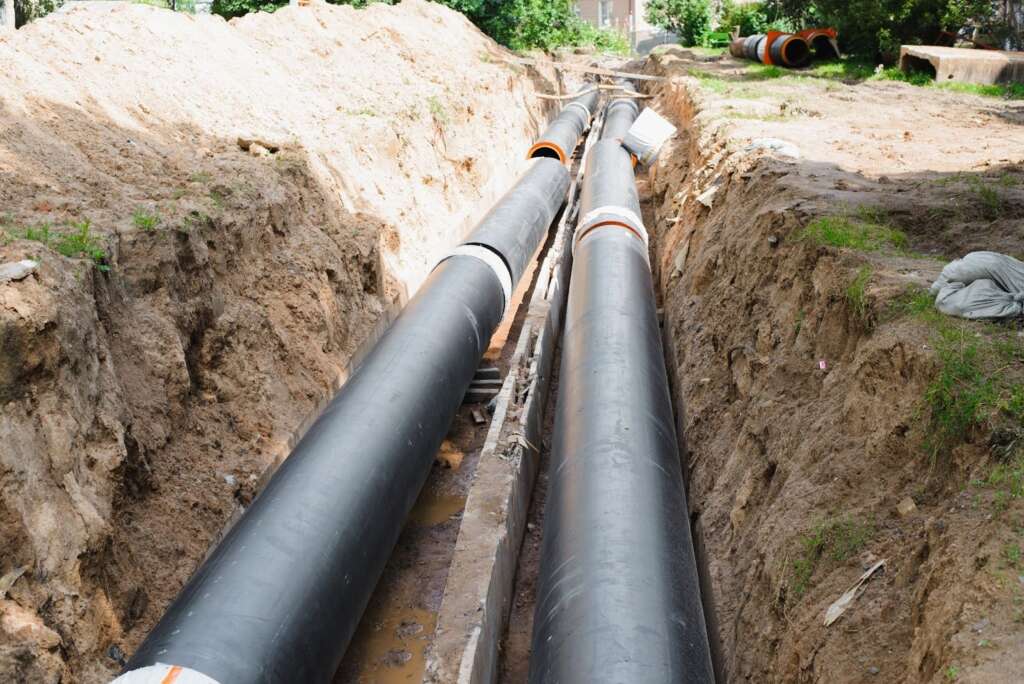Sewer line repairs can be costly and complex for homeowners and businesses. Understanding the factors that influence the cost of these repairs can help you prepare financially and make informed decisions. Whether you’re dealing with a minor clog or a complete replacement, several variables determine how much you’ll pay for sewer line repairs.
The Extent of Damage Affecting the Cost of Sewer Line Repairs
One of the most critical factors influencing the cost of sewer line repairs is the extent of the damage. Minor issues like small cracks or localized clogs may only require minimal intervention, while more severe problems like collapsed pipes or extensive corrosion demand more labor-intensive and costly solutions.
Minor Repairs
Minor sewer line issues are typically easier and less expensive to fix. These may include clearing a clog with a snake or hydro jetting to remove debris buildup. In these cases, costs are usually limited to labor and the use of specialized equipment. However, even minor issues should not be ignored, as they can escalate into more severe problems over time. Prompt attention to these small repairs ensures the sewer system remains functional and prevents costly emergencies.
Major Repairs or Replacements
You may need significant repairs or a complete replacement if your sewer line is severely damaged. Replacement involves excavating your yard, removing the damaged pipe, and installing a new one. The cost of such work can escalate quickly, particularly if heavy machinery or extensive labor is required.
The Type of Sewer Line Repair Method Used
The repair method employed plays a substantial role in the total cost. Traditional trenching methods tend to be more labor-intensive and expensive, while modern techniques like trenchless sewer repair can be more cost-effective in certain situations.
Traditional Trenching
This conventional approach involves digging a trench to access the sewer line, which can damage landscaping, driveways, and other surface structures. While this method may be necessary for severe cases, the costs associated with excavation and restoration can add up quickly.
Trenchless Sewer Repair
Trenchless methods, such as pipe bursting or relining, offer a less invasive alternative. These techniques reduce the need for extensive excavation, lowering costs and minimizing disruption. However, the equipment and expertise required for trenchless repairs may lead to higher upfront costs.
The Cost of Piping Material Used in Sewer Line Repairs
The type of material used for your sewer line also impacts repair costs. Different materials have varying levels of durability, longevity, and expense. PVC is one of the most affordable and commonly used materials for sewer lines, with repairs generally costing less than other options. Older homes often have clay pipes prone to cracking and root intrusion, making repairs more expensive due to their fragility. Cast iron pipes, while durable, can corrode over time, requiring specialized tools and labor for repairs, which increases costs. Copper pipes, though less common in sewer systems, are highly durable but come with higher repair or replacement expenses due to the cost of the material.

Location of the Sewer Line Repair
The physical location of the sewer line significantly affects repair costs. Sewer lines in hard-to-reach areas or beneath structures may require additional labor and specialized equipment. For instance, lines beneath concrete slabs or driveways often demand advanced tools and careful planning to avoid structural damage. Furthermore, the proximity of the sewer line to trees or other vegetation can complicate access and increase the time and expense of repairs.
Urban vs. Rural Areas
In urban areas, sewer lines often run under streets or sidewalks, making access more challenging and costly. Conversely, rural properties may have more accessible sewer lines but face challenges like longer distances to the main line. Urban settings may also require coordination with local utilities to avoid disruptions, adding to the complexity of repairs. Similarly, rural locations can involve navigating uneven terrain, complicating excavation efforts.
Depth of the Sewer Line
The depth at which your sewer line is buried also matters. Deeper lines require more labor and equipment to access, which increases repair costs. Shallow lines are generally easier and cheaper to repair.
Labor and Permitting Costs Associated With Sewer Line Repairs
Labor costs can vary widely depending on your location and the complexity of the repair. In addition, many sewer line repairs require permits from local authorities, adding to the overall expense. Factors such as the cost of living in your area and the demand for skilled labor can also significantly affect labor charges. Moreover, some municipalities may impose additional fees for road closures or traffic redirection during repairs.
Skilled Labor
Sewer line repairs often require highly skilled technicians who charge higher rates for their expertise. The more complex the repair, the more labor hours are needed, increasing costs. Additionally, the availability of experienced technicians in your area can influence rates, as higher demand may result in premium charges. Moreover, emergency repairs often require technicians to work after hours, further driving up labor costs.
Permits and Inspections
Before repairs can begin, you may need to obtain permits and schedule inspections. Permit fees vary by municipality and are often based on the scope of the project. Inspections ensure the work complies with local codes but can add time and expense to the process.
Causes of Sewer Line Damage
Understanding the cause of the damage can help determine the repair cost. Different causes require different solutions, ranging from simple fixes to extensive overhauls.
Tree Root Intrusion
Tree roots are a common cause of sewer line damage. Roots can penetrate pipes, causing blockages and leaks. Removing roots and repairing the damage can be expensive, particularly if the problem is extensive.
Ground Shifting or Settling
Natural ground movement can cause pipes to shift, crack, or collapse. Repairs for these issues often require significant excavation and stabilization efforts, driving up costs.
Age and Wear
Older pipes are more susceptible to corrosion, leaks, and general wear damage. Replacing aged pipes is often the best solution, but due to the scale of the work, it comes with higher costs.
Preventative Sewer Line Repair Maintenance
Regular maintenance can help you avoid costly sewer line repairs in the future. Services like annual inspections, cleaning, and minor repairs can extend the life of your sewer line and save you money in the long run. Regular upkeep also allows for the early detection of potential issues, giving homeowners ample time to address them before they escalate. Furthermore, a well-maintained sewer system ensures optimal performance and reduces the likelihood of unexpected emergencies.
Professional Inspections
Professional inspections, including camera inspections, can identify potential issues before they become major problems. While these services have an upfront cost, addressing issues early can save you significant money.
Routine Cleaning
Regular cleaning helps prevent clogs and buildup, reducing the likelihood of costly blockages. Hydro jetting and other cleaning methods can keep your sewer line in good condition.

Insurance Coverage for Sewer Line Repairs
In some cases, homeowners’ insurance policies may cover sewer line repairs. However, coverage depends on your policy’s specific terms and the damage caused. Reviewing your policy and understanding its limitations is essential to avoid unexpected expenses. Consulting with your insurance provider can clarify what is covered and provide guidance on how to file a claim if needed.
Covered vs. Non-Covered Damage
Insurance may cover sudden and accidental damage, such as that caused by a burst pipe. However, gradual wear and tear or neglect damage is typically excluded. Reviewing your policy and discussing coverage with your provider can help determine your out-of-pocket costs.
Additional Sewer Line Repair Costs to Consider
In addition to the primary repair expenses, sewer line repairs often involve additional costs. These can include restoring landscaping, replacing damaged driveways or sidewalks, and addressing secondary damage caused by sewage backups.
Landscaping Restoration
Excavation can damage lawns, gardens, and other landscaping features. Restoring these areas adds to the overall cost of repairs. Depending on the extent of the damage, you may need to hire professional landscapers to restore your property to its original condition. Hardscaping elements like walkways or patios may also require specialized repairs, increasing expenses.
Damage to Property
Sewage backups can cause damage to your home’s interior, requiring costly cleanup and repairs. Addressing water damage, mold, and other related issues can increase expenses. This type of damage often requires the services of specialized contractors to ensure the home is safe and livable again. Moreover, prolonged exposure to sewage can pose significant health risks, necessitating immediate attention and professional remediation.
Key Takeaways on Sewer Line Repair Costs
Sewer line repairs are influenced by various factors, including the extent of the damage, the type of repair method used, the pipe material, and the location of the sewer line. Labor costs, permitting requirements, and the root cause of the problem also play a significant role in determining the final cost. By understanding these factors and investing in preventative maintenance, you can minimize expenses and ensure your sewer system remains in optimal condition. If you suspect a problem with your sewer line, consult a professional plumber to assess the situation and provide an accurate estimate tailored to your needs.
For more information on sewer line repairs and other plumbing solutions, visit our Castaneda’s Plumbing and Rooter blog!


1 Comment
✏ ✉️ New Transfer - 1.8 BTC from new sender. Review? > https://graph.org/REDEEM-BTC-07-23?hs=b7c3938be33eaee15205e6e9b55701c5& ✏
qs9e8i